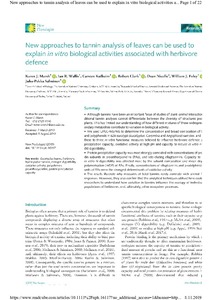New approaches to tannin analysis of leaves can be used to explain in vitro biological activities associated with herbivore defence
Clark R; Foley WJ; Kulheim C; Marsh KJ; Nicolle D; Salminen JP; Wallis IR
New approaches to tannin analysis of leaves can be used to explain in vitro biological activities associated with herbivore defence
Clark R
Foley WJ
Kulheim C
Marsh KJ
Nicolle D
Salminen JP
Wallis IR
WILEY
Julkaisun pysyvä osoite on:
https://urn.fi/URN:NBN:fi-fe2021042821964
https://urn.fi/URN:NBN:fi-fe2021042821964
Tiivistelmä
Although tannins have been an important focus of studies of plant-animal interactions, traditional tannin analyses cannot differentiate between the diversity of structures present in plants. This has limited our understanding of how different mixtures of these widespread secondary metabolites contribute to variation in biological activity. We used UPLC-MS/MS to determine the concentration and broad composition of tannins and polyphenols in 628 eucalypt (Eucalyptus, Corymbia and Angophora) samples, and related these to three in vitro functional measures believed to influence herbivore defence: protein precipitation capacity, oxidative activity at high pH and capacity to reduce in vitro nitrogen (N) digestibility. Protein precipitation capacity was most strongly correlated with concentrations of procyanidin subunits in proanthocyanidins (PAs), and late-eluting ellagitannins. Capacity to reduce in vitro N digestibility was affected most by the subunit composition and mean degree of polymerisation (mDP) of PAs. Finally, concentrations of ellagitannins and prodelphinidin subunits of PAs were the strongest determinants of oxidative activity. The results illustrate why measures of total tannins rarely correlate with animal feeding responses. However, they also confirm that the analytical techniques utilised here could allow researchers to understand how variation in tannins influence the ecology of individuals and populations of herbivores, and, ultimately, other ecosystem processes.
Kokoelmat
- Rinnakkaistallenteet [19218]
